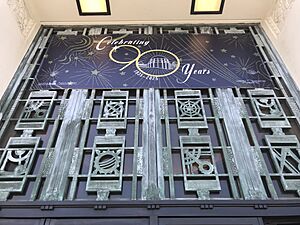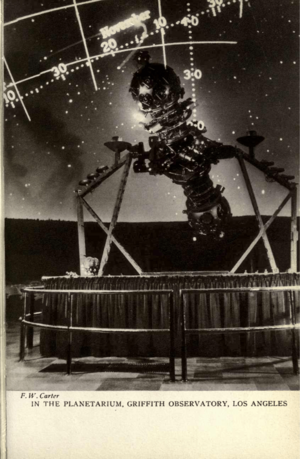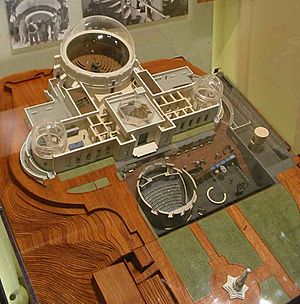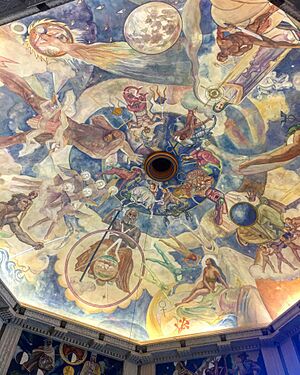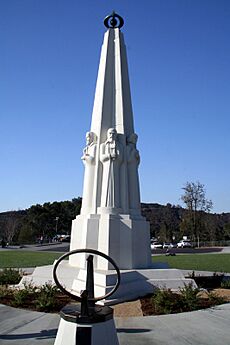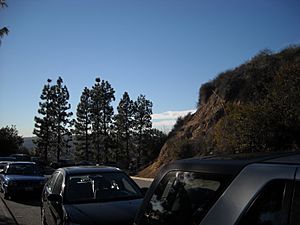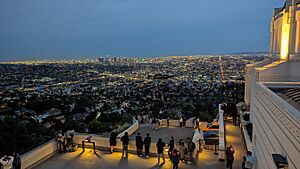Griffith Observatory facts for kids
Quick facts for kids Griffith Observatory |
|
|---|---|
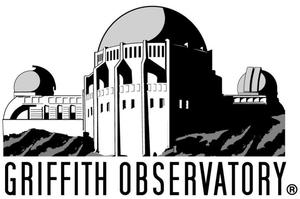 |
|

Griffith Observatory, September 2006
|
|
| Former names | Griffith |
| General information | |
| Architectural style | Greco-Roman and Art Deco |
| Location | Los Feliz, Los Angeles, California, United States |
| Coordinates | 34°07′6″N 118°18′1.2″W / 34.11833°N 118.300333°W |
| Elevation | 1,135 ft (346 m) |
| Construction started | June 20, 1933 |
| Inaugurated | May 14, 1935 |
| Client | Griffith Trust |
| Design and construction | |
| Architect | John C. Austin Frederick M. Ashley |
| Designated: | November 17, 1976 |
| Reference #: | 168 |
The Griffith Observatory is a famous observatory in Los Angeles, California. It sits on the south side of Mount Hollywood inside Griffith Park. From here, you can see amazing views of the city. This includes Downtown Los Angeles, Hollywood, and even the Pacific Ocean.
The observatory is a very popular place for tourists. You can get a great view of the Hollywood Sign from here. It also has many cool displays about space and science. The observatory is named after Griffith J. Griffith, who gave the land and money for it. Since it opened in 1935, admission has always been free. This was Griffith's wish.
Millions of people have looked through the 12-inch (30.5 cm) Zeiss refracting telescope. This makes it one of the most-viewed telescopes in the world! Inside, everything is designed around the theme of space.
Contents
Exploring the Griffith Observatory's History
On December 16, 1896, Griffith J. Griffith gave over 3,000 acres (12 km²) of land to the City of Los Angeles. In his will, he also left money to build an observatory, an exhibit hall, and a planetarium on this land. Griffith wanted everyone to be able to learn about astronomy. He didn't want it to be just for scientists in faraway places.
Griffith made very detailed plans for the observatory. He even asked experts like Walter Sydney Adams and George Ellery Hale for their advice. Construction started on June 20, 1933. Architects John C. Austin and Frederic Morse Ashley designed the building.
The observatory opened to the public on May 14, 1935. It was the third planetarium in the country. In its first five days, more than 13,000 people visited! The building mixes Greek and Beaux-Arts styles with 1930s modern design. Its outside has a cool Greek key pattern.
During World War II, the planetarium helped train pilots. They learned how to navigate using the stars. In the 1960s, it was used again to train Apollo program astronauts. This helped them prepare for the first missions to the Moon.
Supporting the Observatory: The Foundation
The Griffith Observatory Foundation started in 1978. It was first called "Friends of the Observatory." Debra Griffith and Harold Griffith, the grandson of the observatory's founder, started it. Dr. E.C. Krupp, the current Observatory Director, also helped.
This foundation helps the observatory teach people about astronomy. They also supported the big renovation and expansion of the building. The foundation continues to help the observatory share science and space with everyone.
Modern Updates and Expansion
The observatory closed on January 6, 2002, for a big renovation. It also added a lot more exhibit space. It reopened on November 2, 2006, looking just as beautiful on the outside. The renovation cost $93 million. Most of the money came from public bonds.
The project restored the building and replaced the old planetarium dome. New exhibit spaces, a café, and a gift shop were built underground. A new theater, the Leonard Nimoy Event Horizon Theater, was also added.
On May 25, 2008, the Observatory showed visitors live coverage of the Phoenix spacecraft landing on Mars. Ed Krupp has been the director of the Observatory since 1974. He has worked for over 50 years to keep the technology and building up-to-date.
Exploring the Exhibits and Displays
When the observatory first opened in 1935, visitors saw the Foucault pendulum. This pendulum shows how the Earth spins. Other exhibits included a 12-inch (305mm) Zeiss refracting telescope. There was also a special solar telescope and a model of the Moon's north pole.
Griffith wanted an exhibit about evolution. The "Cosmochron" exhibit showed this with a story and slides. This exhibit was there from 1937 until the mid-1960s.
The original design also included a planetarium under the big central dome. Early shows taught about the Moon, planets, and eclipses. In 1964, the planetarium theater was updated with a new Zeiss projector.
The "Café at the End of the Universe" is one of the cafes run by famous chef Wolfgang Puck. Inside, one wall has "The Big Picture," a huge image of the Virgo Cluster of galaxies. It's 152 feet (46 m) long and 20 feet (6 m) high! Visitors can see it up close or through telescopes. In 2006, the old star projector was replaced with a new Zeiss Mark IX Universarium.
The "Centered in the Universe" show uses a high-resolution video system. It also uses the Zeiss Universarium to show the night sky. Actors perform the 30-minute show. You buy tickets for the show separately. Children under 5 can only go to the first show of the day.
The observatory has six main sections:
- The Wilder Hall of the Eye
- The Ahmanson Hall of the Sky
- The W. M. Keck Foundation Central Rotunda
- The Cosmic Connection
- The Gunther Depths of Space Hall
- The Edge of Space Mezzanine
The Wilder Hall of the Eye focuses on tools like telescopes. It shows how they help us see further into space. You can try a Tesla coil and a "Camera Obscura" here.
The Ahmanson Hall of the Sky is about things we see in the sky, like the Sun and Moon. It has a large solar telescope that projects images of the Sun. You can also see a periodic table of elements and learn about day and night, seasons, and Moon phases.
The W. M. Keck Foundation Central Rotunda has beautiful murals on the ceiling. It also features the Foucault pendulum, which shows Earth's rotation. A small exhibit tells about Griffith J. Griffith.
The Cosmic Connection is a long hallway. It shows the history of the universe from the Big Bang to today. It uses hundreds of pieces of astronomy-themed jewelry to show how much time has passed.
The Gunther Depths of Space Hall is on the lower level. It has "The Big Picture" and models of our Solar System. The planets are shown in scale to the Sun. You can also see how much you would weigh on different planets! There's a bronze statue of Albert Einstein sitting on a bench.
The Edge of Space Mezzanine looks over the Depths of Space Hall. It focuses on things closer to Earth, like meteorites. You can see meteorite displays, an asteroid impact simulator, and a large globe of the Moon.
The Amazing Tesla Coil
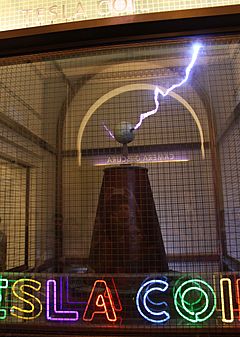
The Observatory has a large Tesla coil on display. It's named "GPO-1" after its inventor, Nikola Tesla. This coil was built in 1910 by Earle Ovington. He built high-voltage generators for medical X-ray machines. His public demonstrations with sparks were very popular.
Ovington designed this coil to make sparks longer than 64 inches (163 cm). An official from Edison Electric Illuminating Company offered $1,000 if the coil could make sparks at least ten feet long. This was for a show at Madison Square Garden.
The machine, called the Million Volt Oscillator, was a huge hit. Sparks would shoot from the coil to another coil 122 inches (310 cm) away. Experts estimated the sparks were at least 1.3 million volts!
Ovington gave the Tesla coils to his friend Frederick Finch Strong. In 1937, Strong donated them to Griffith Observatory. The Observatory only had space for one. Staff member Leon Hall restored it with help from Hollywood special effects expert Kenneth Strickfaden. Strickfaden designed effects for movies like Frankenstein.
Astronomers Monument
In front of the Observatory, you'll find the Astronomers Monument. This monument honors six of the greatest astronomers in history:
- Hipparchus (around 150 BC)
- Nicolaus Copernicus (1473–1543)
- Galileo Galilei (1564–1642)
- Johannes Kepler (1571–1630)
- Isaac Newton (1642–1727)
- William Herschel (1738–1822)
This artwork was created in 1934 by six local artists. It has an armillary sphere on top.
Planning Your Visit to the Observatory
It's free to enter the Griffith Observatory building and grounds. Planetarium shows happen many times a day. There is a small fee for planetarium show tickets.
When the weather is good, the Observatory offers free public telescope viewing every night it's open. This usually starts at 7:00 p.m. You can look through the historic 12-inch Zeiss Refracting Telescope on the roof. There are also portable telescopes outside. These let you see visible objects in the night sky.
There is a small parking lot right next to the Observatory. More parking is available along Western Canyon Road. Parking costs $8–10 an hour. During busy times, the roads can get crowded.
The Los Angeles Department of Transportation (LADOT) offers a low-cost DASH Observatory bus service. It runs from the Vermont/Sunset Metro Red Line station to the Observatory. It also stops at the nearby Greek Theater. You can park for free at the Greek Theater when there are no concerts. From there, you can walk up to the observatory or take the bus. The walk takes about 15–20 minutes. The bus ride is about 5 minutes. The observatory is closed on Mondays.
The Observatory offers fantastic photo opportunities and views. You can see the Pacific Ocean, the Hollywood Sign, and Downtown Los Angeles.
Images for kids
See also
 In Spanish: Observatorio Griffith para niños
In Spanish: Observatorio Griffith para niños
- Don Dixon – Observatory Art Director
- Joy Picus, Los Angeles City Council member, 1977–1991, president of Friends of Griffith Observatory
- Laura Danly – Observatory Curator
- Los Angeles Historic–Cultural Monuments in Hollywood and Los Feliz
- Fabra Observatory – Spanish observatory on a hill overlooking a metropolis


